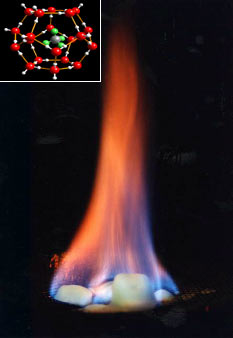Gas Hydrates
Ice that burns
Ice that burns

Methane hydrate burning. Inset shows arrangment of water molecules around a trapped methane molecule.
Image courtesy U.S. Geological Survey.
Gas hydate basics
A gas hydrate is a solid white, ice-like compound that contains gas molecules trapped inside cages of frozen water. Methane (CH4), the dominant component of natural gas, is the main gas in a methane hydrate. Like the natural gas in your home, methane in the gas hydrate burns, can be used for fuel and is a greenhouse gas, but when it burns it looks like flaming ice.
Although common and widespread close to shore, naturally-occurring gas hydrate deposits were unknown before 1970. Whether this newfound source of abundant methane will serve as a much needed energy source or ultimately aggravate global warming remains to be seen.
Gas hydrates form in places where temperatures are low and pressure is relatively high. Marine sediments off the continental shelf provide ideal conditions for gas hydrates to be buried and stable. Gas hydrates predominantly form along continental margins in water depths ranging from 500 meters to 3,500 meters. Since the edge of the continental shelf occurs at about 150 mbsl, gas hydrates intersect the sea floor beyond the oceanward edge of the shelf, on the continental slope.
If temperature and pressure conditions in the ocean change, gas hydates may become unstable and gas could be released. A rapid release could cause slopes to be unstable and generate tsunami, as well release substantial amounts of the greenhouse gas methan to the atmosphere.
The link between gas hydrates and landslides
Where gas hydrates are teetering on the edge of stability, changes in sea level could trigger some escapes of the gas by changing the pressure situation. Gas may escape in an event called a blowout. The blowout may be explosive enough to cause landslides to occur.
There is some evidence that such gas blowouts have taken place in the past. Perhaps such an event occured near the Paleocene to Eocene boundary about 55 miillion years ago and contributed to the global warming detected at that time.
At the Ocean Institute
Students and visitors to the Ocean Institute can try their skills at using a magnetometer to find buried artifacts.
A gas hydrate is a solid white, ice-like compound that contains gas molecules trapped inside cages of frozen water. Methane (CH4), the dominant component of natural gas, is the main gas in a methane hydrate. Like the natural gas in your home, methane in the gas hydrate burns, can be used for fuel and is a greenhouse gas, but when it burns it looks like flaming ice.
Although common and widespread close to shore, naturally-occurring gas hydrate deposits were unknown before 1970. Whether this newfound source of abundant methane will serve as a much needed energy source or ultimately aggravate global warming remains to be seen.
Gas hydrates form in places where temperatures are low and pressure is relatively high. Marine sediments off the continental shelf provide ideal conditions for gas hydrates to be buried and stable. Gas hydrates predominantly form along continental margins in water depths ranging from 500 meters to 3,500 meters. Since the edge of the continental shelf occurs at about 150 mbsl, gas hydrates intersect the sea floor beyond the oceanward edge of the shelf, on the continental slope.
If temperature and pressure conditions in the ocean change, gas hydates may become unstable and gas could be released. A rapid release could cause slopes to be unstable and generate tsunami, as well release substantial amounts of the greenhouse gas methan to the atmosphere.
The link between gas hydrates and landslides
Where gas hydrates are teetering on the edge of stability, changes in sea level could trigger some escapes of the gas by changing the pressure situation. Gas may escape in an event called a blowout. The blowout may be explosive enough to cause landslides to occur.
There is some evidence that such gas blowouts have taken place in the past. Perhaps such an event occured near the Paleocene to Eocene boundary about 55 miillion years ago and contributed to the global warming detected at that time.
At the Ocean Institute
Students and visitors to the Ocean Institute can try their skills at using a magnetometer to find buried artifacts.
Where to find more information:
Methane Gas Hydrates
Methane hydrate basics and information about U.S. deposits.
Minerals Managements Service and U.S. Geological Survey
Flammable Ice
Article from Scientific American. Fee to download article or free to digital subscribers.
Suess, Bohrmann, Gerinert and Lausch, November 1999
in Scientific American
Produced in collaboration with Scripps Institution of Oceanography.
Website by Earthguide.
© 2003-2004 by the Ocean Institute
and the Regents of the University of California.
All rights reserved.
Last modifed Monday, December 10, 2004

